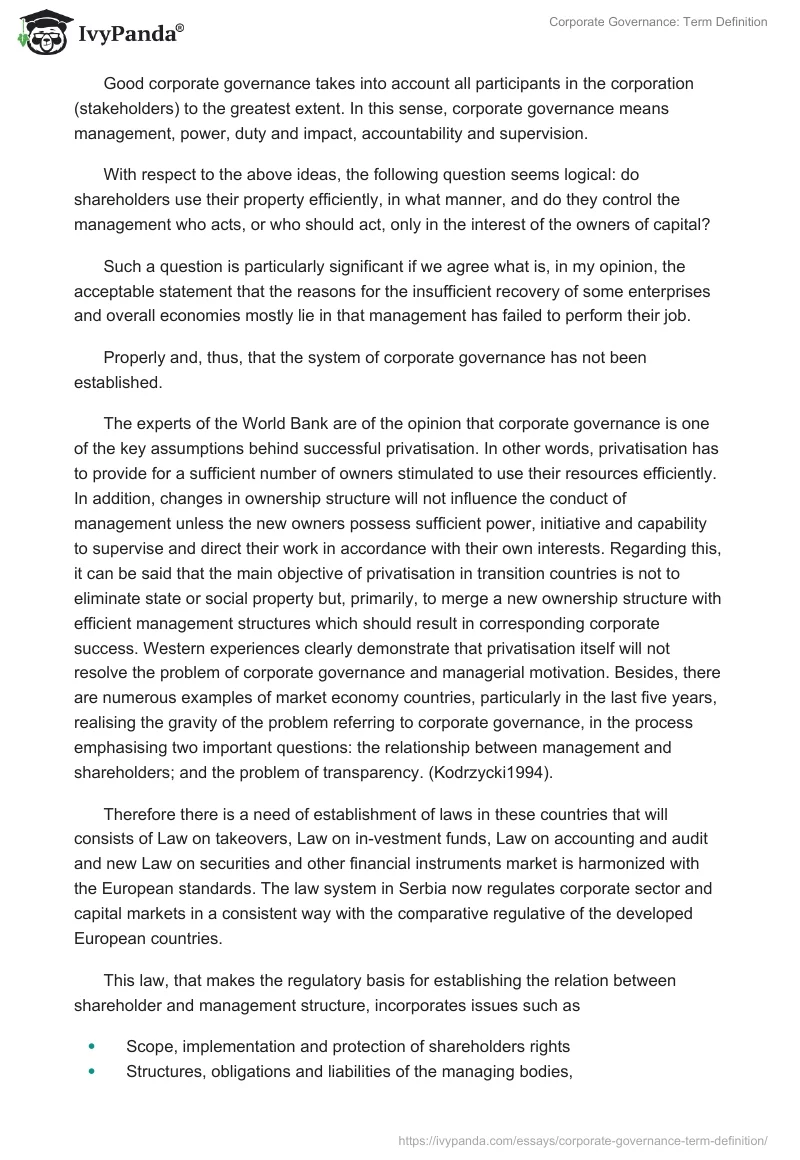Introduction
Corporate governance is a mechanism for reassuring the suppliers of capital that their investments in the firm will not be stolen. Rerolle 2001, states that good corporate governance is a necessary, though not a sufficient condition for secure investment. These are just two, quite different, determinations of corporate governance concept. Although corporate governance can be defined in a variety of ways, generally it involves the mechanisms by which a business enterprise, organized in a limited liability corporate form, is directed and controlled. It usually concerns mechanisms, which holds corporate managers accountable to investors for the use of asset and corporate performance. Further, corporate governance aims to align the actions of the individual parts of an organization toward aggregate mutual benefit. It specifies the relationships between and the distribution of rights and responsibilities among, the main groups of stakeholders – the board of directors, the managers, the shareholders or owners, the workers, the regulators, the customers, the community(Kodrzycki1994).
Reasons why it is an area of interest
The reasons that have made corporate governance an important issue nowadays is because of the need to align most of developing countries corporate companies to meet the standards of the developed countries such as England or US. This will include ensuring that large companies are not state controlled as it is with many developing countries. This move will facilitate greatly the privatisation of all the major companies for effective management and accountability that lacks as a result of their control by the state. In many developing countries the institutional investors are supposed to play a significant role in the process of corporate governance but are not the case in many of these counties. For example, their participation in South Africa companies, apart from the Pension and Share fund, are not significant. However, in institutional investors and banks play an important role in corporate governance in the developed countries as they participates in a great deal in corporate financing and delegating their officers in companies’ managing and supervisory boards. (Kodrzycki1994).
Good corporate governance takes into account all participants in the corporation (stakeholders) to the greatest extent. In this sense, corporate governance means management, power, duty and impact, accountability and supervision.
With respect to the above ideas, the following question seems logical: do shareholders use their property efficiently, in what manner, and do they control the management who acts, or who should act, only in the interest of the owners of capital?
Such a question is particularly significant if we agree what is, in my opinion, the acceptable statement that the reasons for the insufficient recovery of some enterprises and overall economies mostly lie in that management has failed to perform their job.
Properly and, thus, that the system of corporate governance has not been established.
The experts of the World Bank are of the opinion that corporate governance is one of the key assumptions behind successful privatisation. In other words, privatisation has to provide for a sufficient number of owners stimulated to use their resources efficiently. In addition, changes in ownership structure will not influence the conduct of management unless the new owners possess sufficient power, initiative and capability to supervise and direct their work in accordance with their own interests. Regarding this, it can be said that the main objective of privatisation in transition countries is not to eliminate state or social property but, primarily, to merge a new ownership structure with efficient management structures which should result in corresponding corporate success. Western experiences clearly demonstrate that privatisation itself will not resolve the problem of corporate governance and managerial motivation. Besides, there are numerous examples of market economy countries, particularly in the last five years, realising the gravity of the problem referring to corporate governance, in the process emphasising two important questions: the relationship between management and shareholders; and the problem of transparency. (Kodrzycki1994).
Therefore there is a need of establishment of laws in these countries that will consists of Law on takeovers, Law on in-vestment funds, Law on accounting and audit and new Law on securities and other financial instruments market is harmonized with the European standards. The law system in Serbia now regulates corporate sector and capital markets in a consistent way with the comparative regulative of the developed European countries.
This law, that makes the regulatory basis for establishing the relation between shareholder and management structure, incorporates issues such as
- Scope, implementation and protection of shareholders rights
- Structures, obligations and liabilities of the managing bodies,
- Judicial and other forms of protection.
The Law on economic societies introduces improvements in the provisions relating to corporate governance, business combinations, corporate form conversion, disclosure requirement, and company liquidation outside bankruptcy. Another enhancement is the possibility of open and closed joint stock companies’ existence. The provisions relating to limited liability companies have been simplified. Along with the improvements in regulative dealing with the operation of companies, the procedures for registration of new companies and filling of companies’ documents have been much improved in many of the developing countries. This law give obligation of public companies to keep the public informed about the company’s activities, the liability to provide true and accurate data in the prospectus and the issue of insider information and their abuse (Adrian and Bob 2002).


